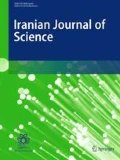Abstract
Composite beam type structures fail in the presence of cracks. While in use the crack depth gradually increases, the structural stiffness decreases and as a result the beam becomes weaker than its earlier conditions. At the end, the beam may collapse because of an initial or developed small crack. Hence, identification of the crack and its severity is a challenge for researchers. In the present work, vibration signatures were used to detect the crack position as well as crack depth in a cracked FRP composite beam. Seven types of epoxy-glass fibres bidirectional (woven) composite beams made of 13 layers oriented along 0°, 7.5°, 15°, 22.5°, 30°, 37.5° and 45° with clamp-free end condition were studied. Fibre orientation effects on the FRP composite beam with varying crack location and crack depth were evaluated using analytical, finite element methods and Sugeno-fuzzy approach. The results were obtained and verified by experiments. The outcomes of all the methods were in good agreement. It was concluded that the natural frequency and mode shape in free vibration were largely affected by orientation of fibre and crack location and its depth.










Similar content being viewed by others
References
ANSYS (2014) Released Version.13, user manual
Cao M, Radzieński M, Xu W, Ostachowicz W (2014) Identification of multiple damage in beams based on robust curvature mode shapes. Mech Syst Signal Process 46:468–480
Ghoneam SM (1995) Dynamic analysis of open cracked laminated composite. Compos Struct 32:3–11
Jensen DW, Crawley EF (1984) Frequency determination techniques for Cantilevered plates with bending-torsion coupling. J Am Inst Aeronaut Astronaut 22(3):415–420
Jones RM (1999) Mechanics of composite materials, 2nd edn. Taylor and Francis
Knibbs RH, Morris JB (1974) The effects of fiber orientation on the physical properties of composites. Composite 5:209–218
Li J, Hua H, Shen R (2008) Dynamic finite element method for generally laminated composite beams. Int J Mech Sci 50:466–480
Majumdar A, Maiti DK, Maity D (2012) Damage assessment of truss structures from changes in natural frequencies using ant colony optimization. Appl Math Comput 218:9759–9772
Nguyen SD, Ngo KN, Tran QT, Choi SB (2013) A new method for beam-damage-diagnosis using adaptive fuzzy neural structure and wavelet analysis. Mech Syst Signal Process 39:181–194
Nikpur K, Dimarogonas A (1988) Local of compliance of composite cracked bodies. Compos Sci Technol 32:209–223
Orhan S (2007) Analysis of free and forced vibration of cracked cantilever beam. NDT I Int 40:443–450
Parhi DR (2005) Navigation of mobile robot using a fuzzy logic controller. J Intell Robotic Syst Theory Appl 42(3):253–273
Tada H, Paris PC, Irwin GR (1973) The stress analysis of cracks Handbook. Del Research Corporation, Hellertown
Teh KK, Huang CC (1979) The vibrations of generally orthotropic beams, a finite element approach. J Sound Vib 62:195–206
Vinson JR, Sierakowski RL (1991) Behaviour of structures composed of composite materials, 1st edn. Martinus Nijhoff, Dordrecht
Xue JN, Jiao XL, Xiao RY, Fang Y (2012) Modal analysis of laminated composite beam based on elastic wave theory. Appl Mech Mater 151:275–280
Zhu F, Deng Z, Zhang J (2013) An integrated approach for structural damage identification using wavelet neuro-fuzzy model. Expert Syst Appl 40:7415–7427
Author information
Authors and Affiliations
Corresponding author
Rights and permissions
About this article
Cite this article
Jena, P.C., Parhi, D.R. & Pohit, G. Dynamic Study of Composite Cracked Beam by Changing the Angle of Bidirectional Fibres. Iran. J. Sci. Technol. Trans. Sci. 40, 27–37 (2016). https://doi.org/10.1007/s40995-016-0006-y
Received:
Accepted:
Published:
Issue Date:
DOI: https://doi.org/10.1007/s40995-016-0006-y




